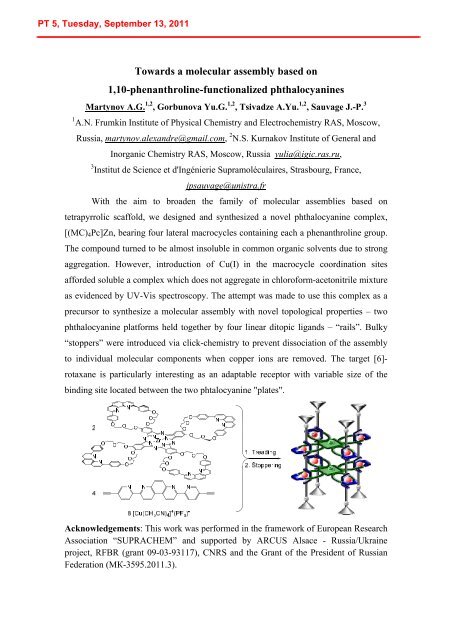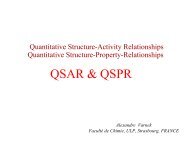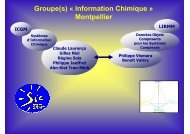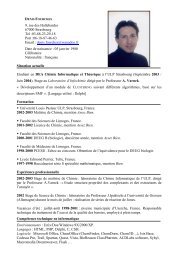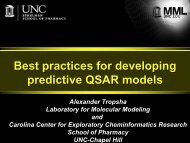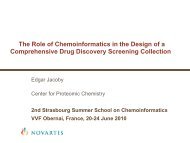International Summer School PROGRAM - Laboratoire d'Infochimie ...
International Summer School PROGRAM - Laboratoire d'Infochimie ...
International Summer School PROGRAM - Laboratoire d'Infochimie ...
Create successful ePaper yourself
Turn your PDF publications into a flip-book with our unique Google optimized e-Paper software.
Towards a molecular assembly based on<br />
1,10-phenanthroline-functionalized phthalocyanines<br />
Martynov A.G. 1,2 , Gorbunova Yu.G. 1,2 , Tsivadze A.Yu. 1,2 , Sauvage J.-P. 3<br />
1<br />
A.N. Frumkin Institute of Physical Chemistry and Electrochemistry RAS, Moscow,<br />
Russia, martynov.alexandre@gmail.com, 2 N.S. Kurnakov Institute of General and<br />
Inorganic Chemistry RAS, Moscow, Russia yulia@igic.ras.ru,<br />
3<br />
Institut de Science et d'Ingénierie Supramoléculaires, Strasbourg, France,<br />
jpsauvage@unistra.fr<br />
With the aim to broaden the family of molecular assemblies based on<br />
tetrapyrrolic scaffold, we designed and synthesized a novel phthalocyanine complex,<br />
[(MC)4Pc]Zn, bearing four lateral macrocycles containing each a phenanthroline group.<br />
The compound turned to be almost insoluble in common organic solvents due to strong<br />
aggregation. However, introduction of Cu(I) in the macrocycle coordination sites<br />
afforded soluble a complex which does not aggregate in chloroform-acetonitrile mixture<br />
as evidenced by UV-Vis spectroscopy. The attempt was made to use this complex as a<br />
precursor to synthesize a molecular assembly with novel topological properties – two<br />
phthalocyanine platforms held together by four linear ditopic ligands – “rails”. Bulky<br />
“stoppers” were introduced via click-chemistry to prevent dissociation of the assembly<br />
to individual molecular components when copper ions are removed. The target [6]rotaxane<br />
is particularly interesting as an adaptable receptor with variable size of the<br />
binding site located between the two phtalocyanine "plates".<br />
Acknowledgements: This work was performed in the framework of European Research<br />
Association “SUPRACHEM” and supported by ARCUS Alsace - Russia/Ukraine<br />
project, RFBR (grant 09-03-93117), CNRS and the Grant of the President of Russian<br />
Federation (МК-3595.2011.3).


